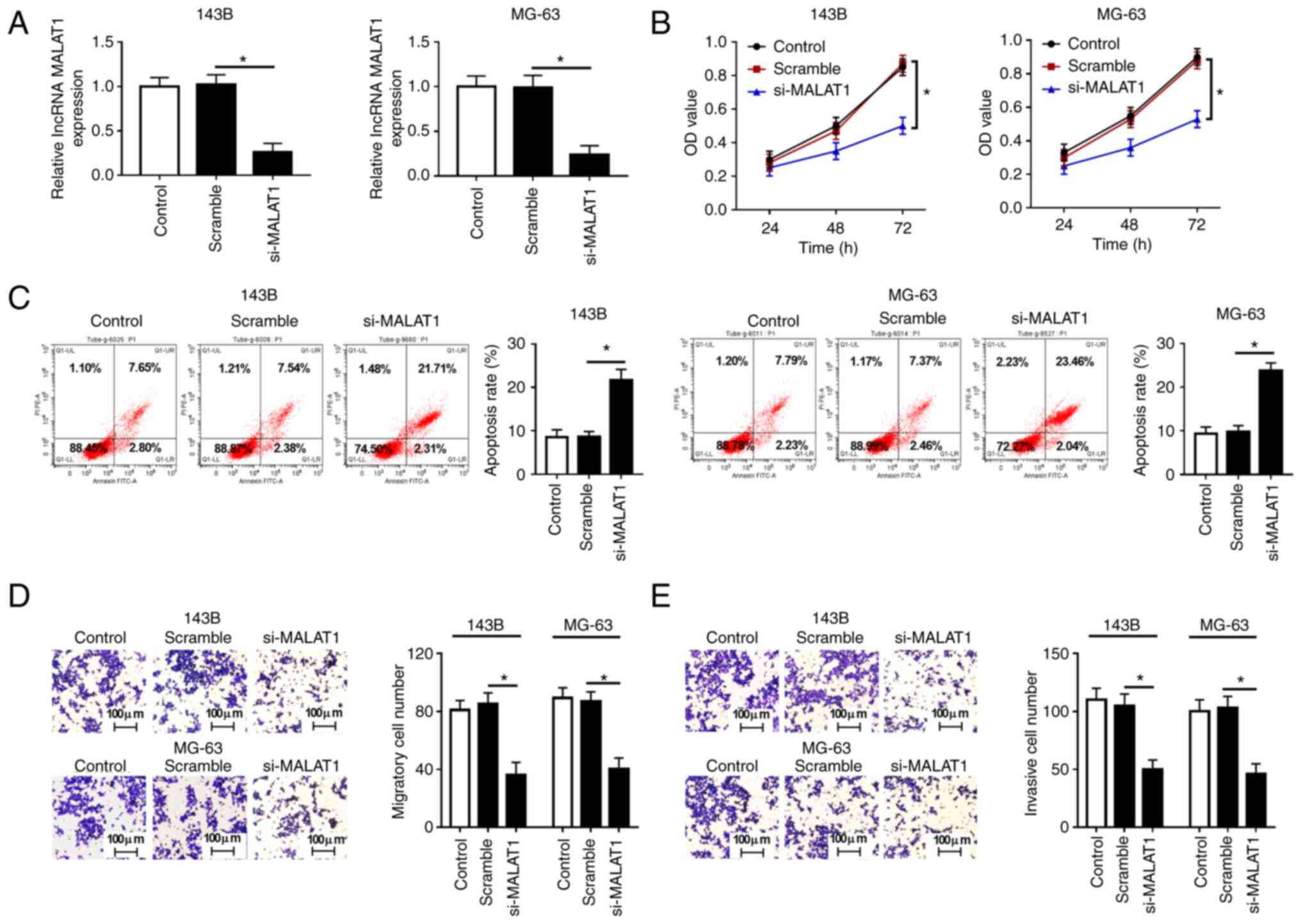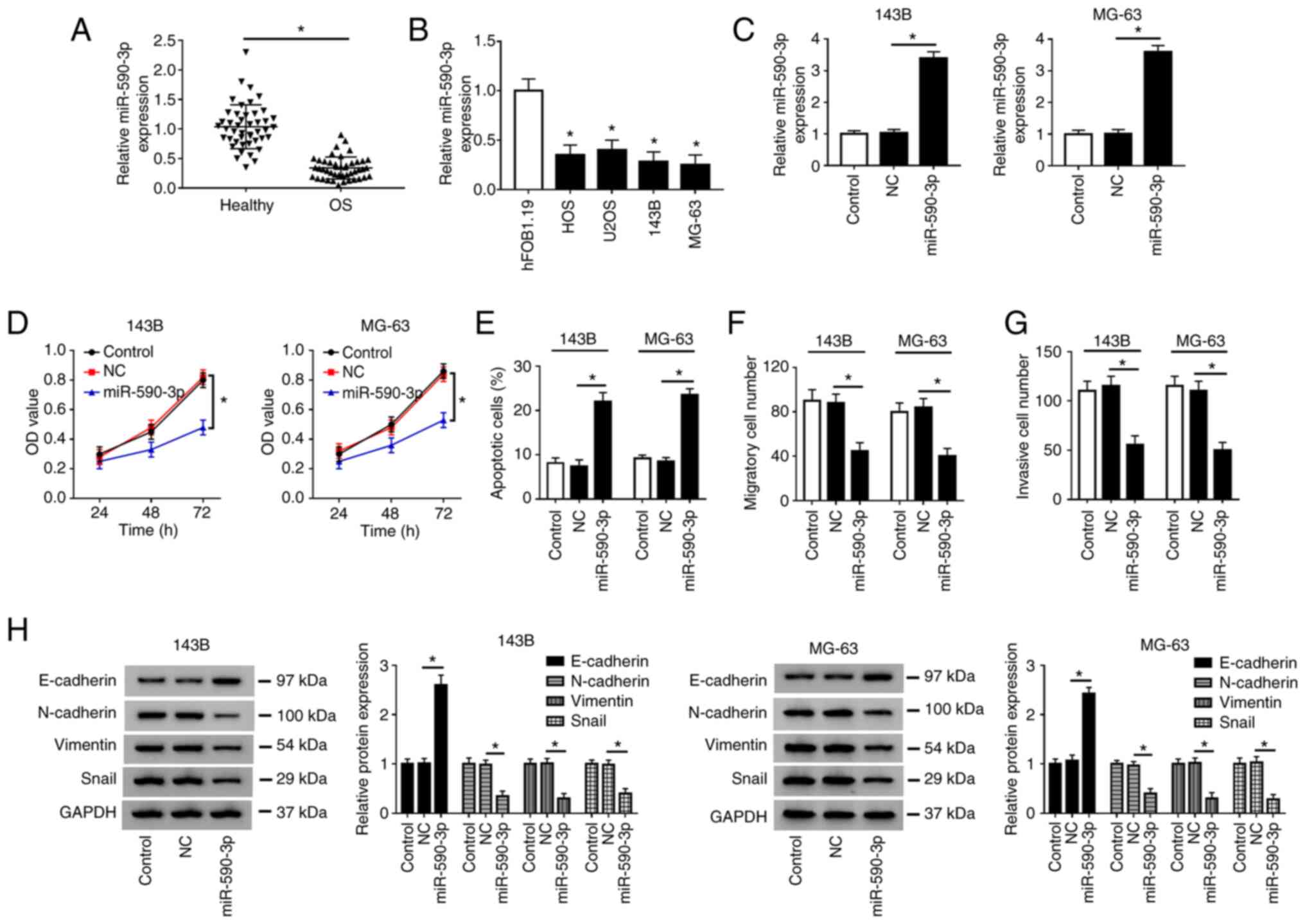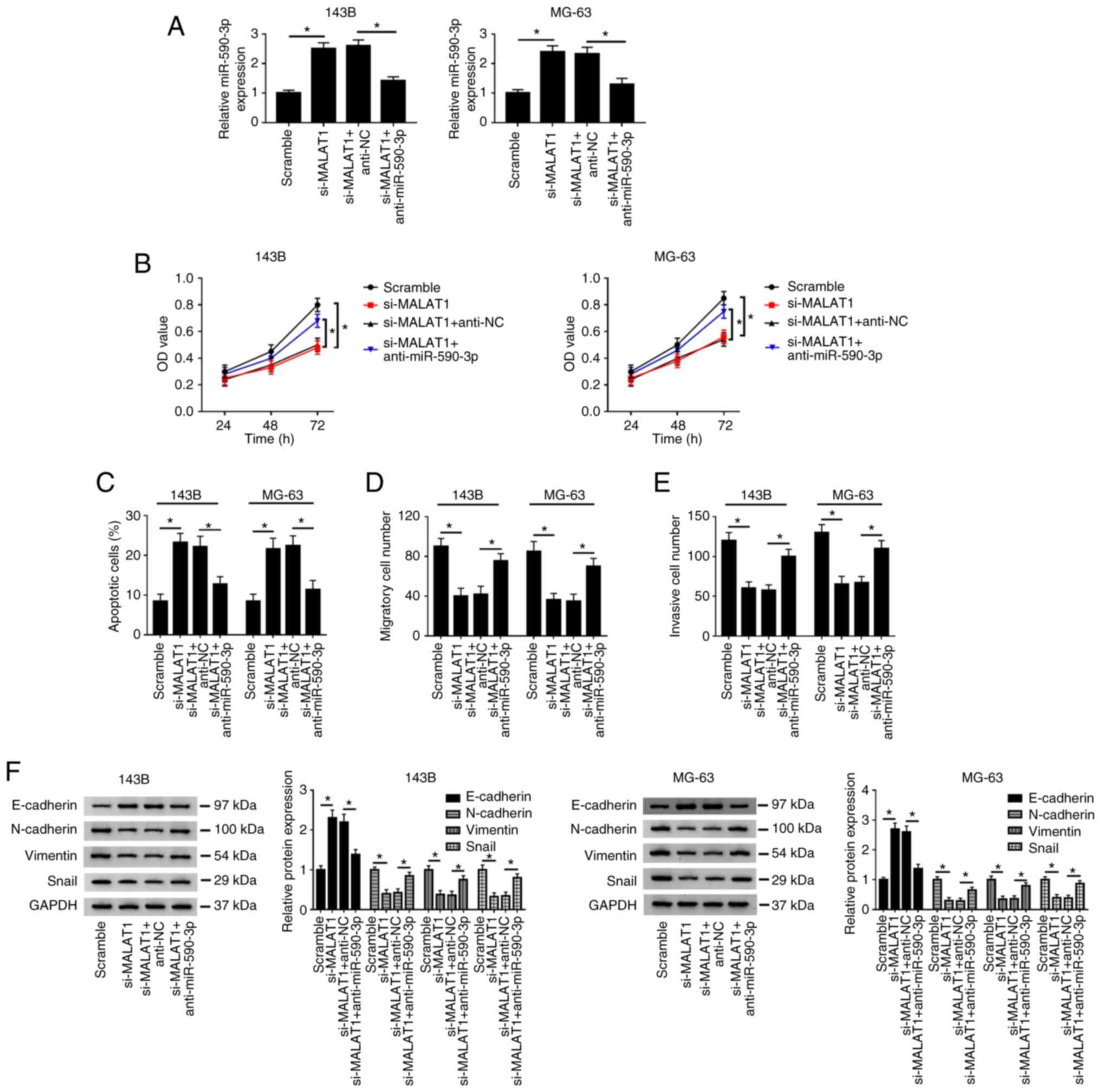|
1
|
Luo Z, Xiao L, Li J, Dong B and Wang C:
Integrative analysis reveals driver long non-coding RNAs in
osteosarcoma. Medicine (Baltimore). 98(e14302)2019.PubMed/NCBI View Article : Google Scholar
|
|
2
|
Mirabello L, Troisi RJ and Savage SA:
International osteosarcoma incidence patterns in children and
adolescents, middle ages and elderly persons. Int J Cancer.
125:229–234. 2009.PubMed/NCBI View Article : Google Scholar
|
|
3
|
Nie Z and Peng H: Osteosarcoma in patients
below 25 years of age: An observational study of incidence,
metastasis, treatment and outcomes. Oncol Lett. 16:6502–6514.
2018.PubMed/NCBI View Article : Google Scholar
|
|
4
|
Luetke A, Meyers PA, Lewis I and Juergens
H: Osteosarcoma treatment-where do we stand? A state of the art
review. Cancer Treat Rev. 40:523–532. 2014.PubMed/NCBI View Article : Google Scholar
|
|
5
|
Mercer TR, Dinger ME and Mattick JS: Long
non-coding RNAs: Insights into functions. Nat Rev Genet.
10:155–159. 2009.PubMed/NCBI View
Article : Google Scholar
|
|
6
|
Zhang J, Hao X, Yin M, Xu T and Guo F:
Long non-coding RNA in osteogenesis: A new world to be explored.
Bone Joint Res. 8:73–80. 2019.PubMed/NCBI View Article : Google Scholar
|
|
7
|
Li JP, Liu LH, Li J, Chen Y, Jiang XW,
Ouyang YR, Liu YQ, Zhong H, Li H and Xiao T: Microarray expression
profile of long noncoding RNAs in human osteosarcoma. Biochem
Biophys Res Commun. 433:200–206. 2013.PubMed/NCBI View Article : Google Scholar
|
|
8
|
Wang L, Li S, Qi L and Ling L: Long
noncoding RNA HCG9 promotes osteosarcoma progression through RAD51
by acting as a ceRNA of miR-34b-3p. Mediators Inflamm: Aug 18, 2021
(Epub ahead of print).
|
|
9
|
Zhon Y, Feng D, Gu X, Gao A and Liu Y: The
role and clinical significance of long noncoding RNA zinc finger
E-box-binding homeobox two antisense RNA 1 in promoting
osteosarcoma cancer cell proliferation, inhibiting apoptosis and
increasing migration by regulating miR-145. Anticancer Drugs.
32:168–177. 2021.PubMed/NCBI View Article : Google Scholar
|
|
10
|
Ding L, Liu T, Qu Y, Kang Z, Guo L, Zhang
H, Jiang J, Qu F, Ge W and Zhang S: lncRNA MELTF-AS1 facilitates
osteosarcoma metastasis by modulating MMP14 expression. Mol Ther
Nucleic Acids. 26:787–797. 2021.PubMed/NCBI View Article : Google Scholar
|
|
11
|
Chen R, Wang G, Zheng Y, Hua Y and Cai Z:
Long non-coding RNAs in osteosarcoma. Oncotarget. 8:20462–20475.
2017.PubMed/NCBI View Article : Google Scholar
|
|
12
|
Li ZX, Zhu QN, Zhang HB, Hu Y, Wang G and
Zhu YS: MALAT1: A potential biomarker in cancer. Cancer Manag Res.
10:6757–6768. 2018.PubMed/NCBI View Article : Google Scholar
|
|
13
|
Li Z, Yu X and Shen J: Long non-coding
RNAs: Emerging players in osteosarcoma. Tumour Biol. 37:2811–2816.
2016.PubMed/NCBI View Article : Google Scholar
|
|
14
|
Sun Y and Qin B: Long noncoding RNA MALAT1
regulates HDAC4-mediated proliferation and apoptosis via decoying
of miR-140-5p in osteosarcoma cells. Cancer Med. 7:4584–4597.
2018.PubMed/NCBI View Article : Google Scholar
|
|
15
|
Duan G, Zhang C, Xu C, Xu C, Zhang L and
Zhang Y: Knockdown of MALAT1 inhibits osteosarcoma progression via
regulating the miR34a/cyclin D1 axis. Int J Oncol. 54:17–28.
2019.PubMed/NCBI View Article : Google Scholar
|
|
16
|
Lynam-Lennon N, Maher SG and Reynolds JV:
The roles of microRNA in cancer and apoptosis. Biol Rev Camb Philos
Soc. 84:55–71. 2009.PubMed/NCBI View Article : Google Scholar
|
|
17
|
Di Leva G, Garofalo M and Croce CM:
MicroRNAs in cancer. Annu Rev Pathol. 9:287–314. 2014.PubMed/NCBI View Article : Google Scholar
|
|
18
|
Chen B, Xia Z, Deng YN, Yang Y, Zhang P,
Zhu H, Xu N and Liang S: Emerging microRNA biomarkers for
colorectal cancer diagnosis and prognosis. Open Biol.
9(180212)2019.PubMed/NCBI View Article : Google Scholar
|
|
19
|
Pang H, Zheng Y, Zhao Y, Xiu X and Wang J:
miR-590-3p suppresses cancer cell migration, invasion and
epithelial-mesenchymal transition in glioblastoma multiforme by
targeting ZEB1 and ZEB2. Biochem Biophys Res Commun. 468:739–745.
2015.PubMed/NCBI View Article : Google Scholar
|
|
20
|
Abdolvahabi Z, Nourbakhsh M, Hosseinkhani
S, Hesari Z, Alipour M, Jafarzadeh M, Ghorbanhosseini SS, Seiri P,
Yousefi Z, Yarahmadi S and Golpour P: MicroRNA-590-3P suppresses
cell survival and triggers breast cancer cell apoptosis via
targeting sirtuin-1 and deacetylation of p53. J Cell Biochem.
120:9356–9368. 2019.PubMed/NCBI View Article : Google Scholar
|
|
21
|
Dou Y, Zhu K, Sun Z, Geng X and Fang Q:
Screening of disorders associated with osteosarcoma by integrated
network analysis. Biosci Rep: May 21, 2019 (Epub ahead of
print).
|
|
22
|
Wang WT, Qi Q, Zhao P, Li CY, Yin XY and
Yan RB: miR-590-3p is a novel microRNA which suppresses
osteosarcoma progression by targeting SOX9. Biomed Pharmacother.
107:1763–1769. 2018.PubMed/NCBI View Article : Google Scholar
|
|
23
|
Long J, Bai Y, Yang X, Lin J, Yang X, Wang
D, He L, Zheng Y and Zhao H: Construction and comprehensive
analysis of a ceRNA network to reveal potential prognostic
biomarkers for hepatocellular carcinoma. Cancer Cell Int.
19(90)2019.PubMed/NCBI View Article : Google Scholar
|
|
24
|
Ren D, Zheng H, Fei S and Zhao JL: MALAT1
induces osteosarcoma progression by targeting miR-206/CDK9 axis. J
Cell Physiol. 234:950–957. 2018.PubMed/NCBI View Article : Google Scholar
|
|
25
|
Sun Z, Zhang T and Chen B: Long non-coding
RNA metastasis-associated lung adenocarcinoma transcript 1 (MALAT1)
promotes proliferation and metastasis of osteosarcoma cells by
targeting c-Met and SOX4 via miR-34a/c-5p and miR-449a/b. Med Sci
Monit. 25:1410–1422. 2019.PubMed/NCBI View Article : Google Scholar
|
|
26
|
Zhang Y, Dai Q, Zeng F and Liu H: MALAT1
Promotes the proliferation and metastasis of osteosarcoma cells by
activating the Rac1/JNK pathway via targeting MiR-509. Oncol Res:
Apr 27, 2018 (Epub ahead of print).
|
|
27
|
Chen Y, Huang W, Sun W, Zheng B, Wang C,
Luo Z, Wang J and Yan W: LncRNA MALAT1 promotes cancer metastasis
in osteosarcoma via activation of the PI3K-Akt signaling pathway.
Cell Physiol Biochem. 51:1313–1326. 2018.PubMed/NCBI View Article : Google Scholar
|
|
28
|
Maximov VV, Akkawi R, Khawaled S, Salah Z,
Jaber L, Barhoum A, Or O, Galasso M, Kurek KC, Yavin E and Aqeilan
RI: MiR-16-1-3p and miR-16-2-3p possess strong tumor suppressive
and antimetastatic properties in osteosarcoma. Int J Cancer.
145:3052–3063. 2019.PubMed/NCBI View Article : Google Scholar
|
|
29
|
Rohini M, Gokulnath M, Miranda PJ and
Selvamurugan N: miR-590-3p inhibits proliferation and promotes
apoptosis by targeting activating transcription factor 3 in human
breast cancer cells. Biochimie. 154:10–18. 2018.PubMed/NCBI View Article : Google Scholar
|
|
30
|
Gu L, Lu LS, Zhou DL and Liu ZC: UCA1
promotes cell proliferation and invasion of gastric cancer by
targeting CREB1 sponging to miR-590-3p. Cancer Med. 7:1253–1263.
2018.PubMed/NCBI View Article : Google Scholar
|
|
31
|
Chen L, Wang W, Zhu S, Jin X, Wang J, Zhu
J and Zhou Y: MicroRNA-590-3p enhances the radioresistance in
glioblastoma cells by targeting LRIG1. Exp Ther Med. 14:1818–1824.
2017.PubMed/NCBI View Article : Google Scholar
|
|
32
|
Salem M, Shan Y, Bernaudo S and Peng C:
miR-590-3p targets cyclin G2 and FOXO3 to promote ovarian cancer
cell proliferation, invasion, and spheroid formation. Int J Mol
Sci. 20(1810)2019.PubMed/NCBI View Article : Google Scholar
|
|
33
|
Feng ZY, Xu XH, Cen DZ, Luo CY and Wu SB:
miR-590-3p promotes colon cancer cell proliferation via
Wnt/beta-catenin signaling pathway by inhibiting WIF1 and DKK1. Eur
Rev Med Pharmacol Sci. 21:4844–4852. 2017.PubMed/NCBI
|
|
34
|
Hu R, Zhu X, Chen C, Xu R, Li Y and Xu W:
RNA-binding protein PUM2 suppresses osteosarcoma progression via
partly and competitively binding to STARD13 3'UTR with miRNAs. Cell
Prolif. 51(e12508)2018.PubMed/NCBI View Article : Google Scholar
|















